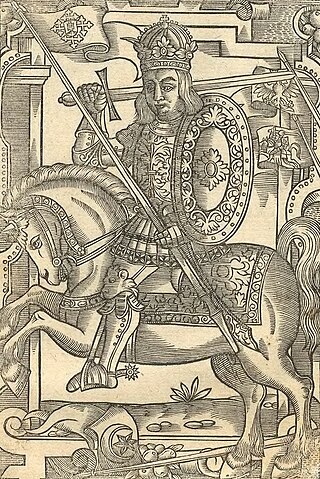Year 1348 (MCCCXLVIII) was a leap year starting on Tuesday of the Julian calendar, the 1348th year of the Common Era (CE) and Anno Domini (AD) designations, the 348th year of the 2nd millennium, the 48th year of the 14th century, and the 9th and pre-final year of the 1340s decade.

Kernavė was a medieval capital of the Grand Duchy of Lithuania and today is a tourist attraction and an archeological site. It is located in the Širvintos district municipality located in southeast Lithuania. A Lithuanian state cultural reserve was established in Kernavė in 1989. In 2004 Kernavė Archaeological Site was included into UNESCO world heritage list.

Novogrudok or Navahrudak is a town in Grodno Region, Belarus. It serves as the administrative center of Novogrudok District. As of 2023, it has a population of 28,021.

Ukmergė is a city in Vilnius County, Lithuania, located 78 km (48 mi) northwest of Vilnius, with a population of about 20,000.
Voruta may have been the capital city of the Grand Duchy of Lithuania and the Kingdom of Lithuania during the reign of king Mindaugas in the 13th century. Voruta is mentioned briefly in a written source only once and its exact location is unknown. Despite all the uncertainties, the concept of Voruta is well-known and popular in Lithuania.

The Act of Tilsit was an act, signed in Tilsit by 24 members of the National Council of Lithuania Minor on November 30, 1918. Signatories demanded unification of Lithuania Minor and Lithuania Proper into a single Lithuanian state. This would mean detaching the northern areas of East Prussia, inhabited by Prussian Lithuanians, from the German Empire.
Voruta is a Lithuanian weekly historical newspaper, founded in 1989 by Juozas Vercinkevičius.

Kazys Almenas was a Lithuanian physicist, writer, essayist, and publisher.

The Battle of Durbe was a medieval battle fought near Durbe, 23 km (14 mi) east of Liepāja, in present-day Latvia during the Livonian Crusade. On 13 July 1260, the Samogitians soundly defeated the joint forces of the Teutonic Knights from Prussia and the Livonian Order from Livonia. Some 150 knights were killed, including Livonian master Burkhard von Hornhausen and Prussian land marshal Heinrich Botel. It was by far the largest defeat of the knights in the 13th century: in the second-largest, the Battle of Aizkraukle, 71 knights were killed. The battle inspired the Great Prussian Uprising and the rebellions of the Semigallians, the Couronians, and the Oeselians. The battle undid two decades of Livonian conquests and it took some thirty years for the Livonian Order to restore its control.

Upytė is a small village in Panevėžys district municipality in northern Lithuania. It is situated some 12 km southwest of Panevėžys on the banks of Vešeta Creek. It is now the capital of an elderate. In 1987 it had 580 residents. In the Lithuanian language, Upytė is a diminutive form of the word upė, which means river.

Juozas Ambrazevičius or Juozas Brazaitis, was a Lithuanian literary historian, better known for his political career and nationalistic views. He was the acting Prime Minister of the Provisional Government of Lithuania from June 23, 1941 to August 5, 1941.

Postilė is a 1000-page postil written in the Lithuanian language by Jonas Bretkūnas in 1591. It was designed for the purposes of Protestant priests serving Lithuanian communities in East Prussia. The book was used until the 18th century. Postilė is one earliest works in Lithuanian that were not merely translations but also included original texts. It contains much ethnographic data about everyday life of the common people. About 30 copies of Postilė survive; 10 of them are kept in Lithuanian libraries and museums.

The first known record of the name of Lithuania is in a 9 March 1009 story of Saint Bruno recorded in the Quedlinburg Chronicle. The Chronicle recorded a Latinized form of the Old Church Slavonic word for Lithuania — Литъва — Latinized as Litva. Although it is clear the name originated from a Baltic language, scholars still debate the meaning of the word.
RollkommandoHamann was a small mobile unit that committed mass murders of Lithuanian Jews in the countryside in July–October 1941, with an estimated death toll of at least 60,000 Jews. The unit was also responsible for many murders in Latvia from July through August 1941. At the end of 1941 the destruction of Lithuanian Jewry was effectively accomplished by Hamann's unit in the countryside, by the Ypatingasis būrys in the Ponary massacre, and by the Tautinio Darbo Apsaugos Batalionas (TDA) in the Ninth Fort in Kaunas. In about six months an estimated 80% of all Lithuanian Jews were killed. The remaining few were spared for use as a labor force and concentrated in urban ghettos, mainly the Vilna and Kaunas Ghettos.

Mindaugas is the first known Grand Duke of Lithuania and the only crowned King of Lithuania. Little is known of his origins, early life, or rise to power; he is mentioned in a 1219 treaty as an elder duke, and in 1236 as the leader of all the Lithuanians. The contemporary and modern sources discussing his ascent mention strategic marriages along with banishment or murder of his rivals. He extended his domain into regions southeast of Lithuania proper during the 1230s and 1240s. In 1250 or 1251, during the course of internal power struggles, he was baptised as a Roman Catholic; this action enabled him to establish an alliance with the Livonian Order, a long-standing antagonist of the Lithuanians. By 1245, Mindaugas was already being referred to as "the highest king" in certain documents. During the summer of 1253, he was crowned King of Lithuania, ruling between 300,000 and 400,000 subjects.

Varnikai is a small village located in the Trakai District Municipality in Lithuania. The population is 75 inhabitants according to the 2011 census.

Petras Tarasenka was a Lithuanian military officer and a prominent archeologist and writer. He is known for popularizing archeology in Lithuania and was a respected scientific figure both during its independence and Soviet occupation.












